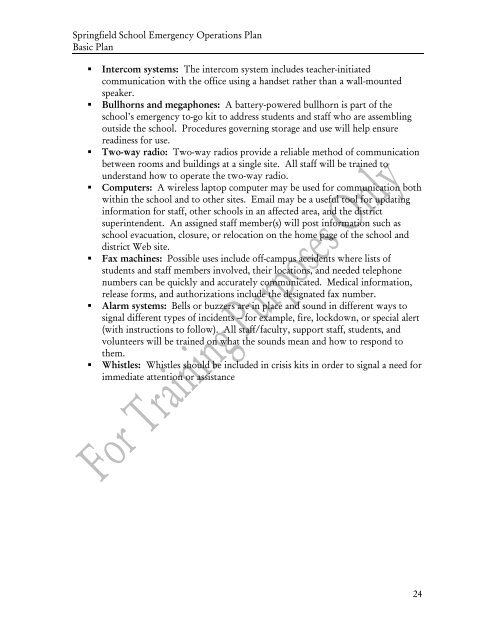Sample School Emergency Operations Plan
Sample School Emergency Operations Plan
Sample School Emergency Operations Plan
Create successful ePaper yourself
Turn your PDF publications into a flip-book with our unique Google optimized e-Paper software.
Springfield <strong>School</strong> <strong>Emergency</strong> <strong>Operations</strong> <strong>Plan</strong><br />
Basic <strong>Plan</strong><br />
Intercom systems: The intercom system includes teacher-initiated<br />
communication with the office using a handset rather than a wall-mounted<br />
speaker.<br />
Bullhorns and megaphones: A battery-powered bullhorn is part of the<br />
school’s emergency to-go kit to address students and staff who are assembling<br />
outside the school. Procedures governing storage and use will help ensure<br />
readiness for use.<br />
Two-way radio: Two-way radios provide a reliable method of communication<br />
between rooms and buildings at a single site. All staff will be trained to<br />
understand how to operate the two-way radio.<br />
Computers: A wireless laptop computer may be used for communication both<br />
within the school and to other sites. Email may be a useful tool for updating<br />
information for staff, other schools in an affected area, and the district<br />
superintendent. An assigned staff member(s) will post information such as<br />
school evacuation, closure, or relocation on the home page of the school and<br />
district Web site.<br />
Fax machines: Possible uses include off-campus accidents where lists of<br />
students and staff members involved, their locations, and needed telephone<br />
numbers can be quickly and accurately communicated. Medical information,<br />
release forms, and authorizations include the designated fax number.<br />
Alarm systems: Bells or buzzers are in place and sound in different ways to<br />
signal different types of incidents – for example, fire, lockdown, or special alert<br />
(with instructions to follow). All staff/faculty, support staff, students, and<br />
volunteers will be trained on what the sounds mean and how to respond to<br />
them.<br />
Whistles: Whistles should be included in crisis kits in order to signal a need for<br />
immediate attention or assistance<br />
24
















